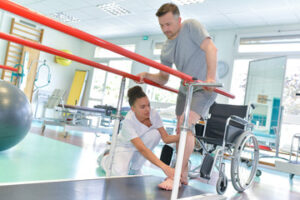Water damage can be caused by flooding, heavy rainfall, burst pipes, sewage backups, and more. Fortunately, most homeowner’s insurance policies cover this type of damage.

If your insurance company denies your claim or offers an inadequate settlement, consider hiring a water damage attorney to help you fight for fair compensation. In the meantime, learn how to minimize water damage in your home. Visit https://www.allproutah.com for more information.
Water damage can be caused by many factors, including flooding, leaky roofs, storms, broken or faulty appliances, and poor drainage. Regardless of the cause, water damage can lead to irreparable damage to furnishings and structures. It can also be a major health and safety issue, resulting in the growth of mold and mildew, rotting wood, and structural problems.
The best way to prevent water damage is through regular maintenance and inspections. For example, homeowners should clean their gutters at least twice a year to prevent blockages and ensure proper drainage. They should also be sure to disconnect their outdoor hoses in the fall to prevent them from freezing and bursting, which can cause serious problems. In addition, they should create a checklist to follow when performing home renovations to protect their plumbing systems and ensure proper drainage during construction.
Leaking pipes are another significant source of water damage. It is important to listen for dripping sounds at night when noise pollution is minimal, and to check for warped floorboards or paint as early moisture detection can help prevent expensive repair bills. It is also a good idea to keep an eye on humidity levels, as high moisture can contribute to hidden leaks.
It is also helpful to understand how different materials react to water, as some will absorb it more quickly than others. For example, tiles will retain more water than wood, and thicker paints will soak up more than thin paint. This can be a useful tool when considering whether to replace or repair damaged items, as it may be cheaper to purchase new items rather than attempt to restore older ones. Water damage situations can be terrifying, but it is important to remain calm and take the appropriate action.
Finding the Source of the Water
When it comes to water damage, hidden leaks are often the culprit. They can be caused by a variety of factors, including broken water lines and malfunctioning appliances. Undiscovered leaks can lead to the deterioration of floors, walls, and cabinetry as well as the growth of mold and other bacteria.
The good news is that there are a few simple tricks homeowners can use to find the source of the problem. One way is to use a moisture detector and look for areas with high levels of moisture. Another method is to cut a small hole in the wall or floor near the area of water damage and look inside. This will help you pinpoint the exact location of the leak and make it easier to get it fixed.
One important factor in identifying the source of the leak is knowing how long the water has been there. This will help you determine the extent of the damage and take appropriate action.
If the water has been there for a short amount of time, it may not have had enough time to cause warping or other structural changes. Older water damage, on the other hand, will typically be soft and mushy to the touch.
It is also possible to determine the age of water damage by observing how it has affected building materials. For example, if the wood in the ceiling or walls has started to swell, it is likely that the leak has been there for a while.
If you notice signs of water damage, it is important to call a professional as soon as possible. They can handle everything from locating the leak to cleaning up the damage and drying out the property. They can also assist you in filing an insurance claim if necessary.
Documenting the Damage
Using the right tools and following safety procedures, you can document the damage to your property in a way that makes it easy for restoration professionals to understand. Take wide shots of the affected areas, as well as close-ups of any damaged items and furnishings. It’s also a good idea to include the original value of the items in your photos and reports.
In addition to taking photographs, you should write a detailed description of the water damage. This includes information like the cause of the water damage (burst pipe, flood, etc.), the exact location of the affected area(s), and how long the property was exposed to the water. You should also note any health concerns that arose as a result of the incident, such as odors or mold growth.
Once you have a thorough record of the damage, it’s time to get in touch with your insurance provider. This is a great opportunity to review your policy so that you can better understand what is covered in the event of a water damage disaster.
Keep in mind that insurance companies can often underestimate the true cost of restoration and rebuilding a home, especially during times of labor shortages and inflated materials costs. This is why it’s a good idea to consider hiring a public adjuster, who can help you navigate the insurance claim process and ensure that you receive the full amount you’re entitled to.
Make it easier for yourself and your team to complete and document water damage inspections by using magicplan. This inspection management platform enables your team to collaborate remotely on site and provide real-time feedback, as well as automatically generate reports in PDF, Excel, Word, or shareable weblink after every assessment.
Cleaning Up the Damage
The first step in water damage remediation is to stop the flow of the contaminated water. This involves turning off the water supply and shutting off electrical appliances in the area.
Once this is done, it’s time to assess the extent of the damage and clean up as much as possible. Depending on the severity of the water damage, some materials may need to be removed, such as drywall down to the studs or carpeting. This will allow the remaining material to dry more efficiently and prevent the growth of mold and mildew.
Porous materials like carpeting, rugs, and fabrics should be removed as soon as possible. They can cause permanent damage to the items they touch, and they’ll also hold moisture that can lead to mold and mildew. Non-porous materials, on the other hand, can be cleaned and sanitized thoroughly to prevent further damage.
It’s also important to note that Category 3 water (black water) should be avoided. This type of water contains sewage and other contaminants that can be harmful to human health if ingested. It’s best to leave this type of water damage cleanup to professionals who are trained in dealing with contaminated materials.
After removing the excess water and drying out the affected area, it’s time to get back to normal. This will take a lot of work, including replacing damaged flooring and walls. It’s also important to keep in mind that the longer you wait to start water damage repair, the worse the damage will be. Wet materials will start developing serious problems like mold in just 24 hours, so it’s crucial to get started as soon as possible.
Repairing the Damage
Water damage can be devastating, not only to a home but also to the possessions inside. It’s important to act quickly, taking steps like shutting off the water source and turning off any affected utilities to limit the amount of damage done. Then it’s time to assess the damage, with the help of a professional if necessary.
Once the damage has been assessed, it’s time to start the cleanup process. This includes removing all standing water and using fans to dry out the area. It’s also important to take pictures of all the affected areas and belongings, as this will be helpful for insurance claims later on.
It’s important to clean up the water damage as soon as possible, because mold and mildew can begin growing in just 24 hours. This is why it’s a good idea to hire a professional that specializes in water damage restoration, as they have the equipment and expertise needed to clean up and repair the property.
In some cases, certain building materials may need to be removed and replaced in order to fully dry out the structure. This can include drywall down to the studs, carpet padding, and even flooring. It’s important to make sure all affected materials are inspected and cleaned thoroughly before replacing them.
Most cases of water damage are covered by homeowners’ insurance policies, so it’s a good idea to speak with your agent and schedule an inspection with a loss adjuster as soon as possible. It’s also a good idea to get at least three or four professional estimates from companies that specialize in water damage repair and restoration. This can be used as leverage when negotiating with your insurance company to get the repairs you need.
